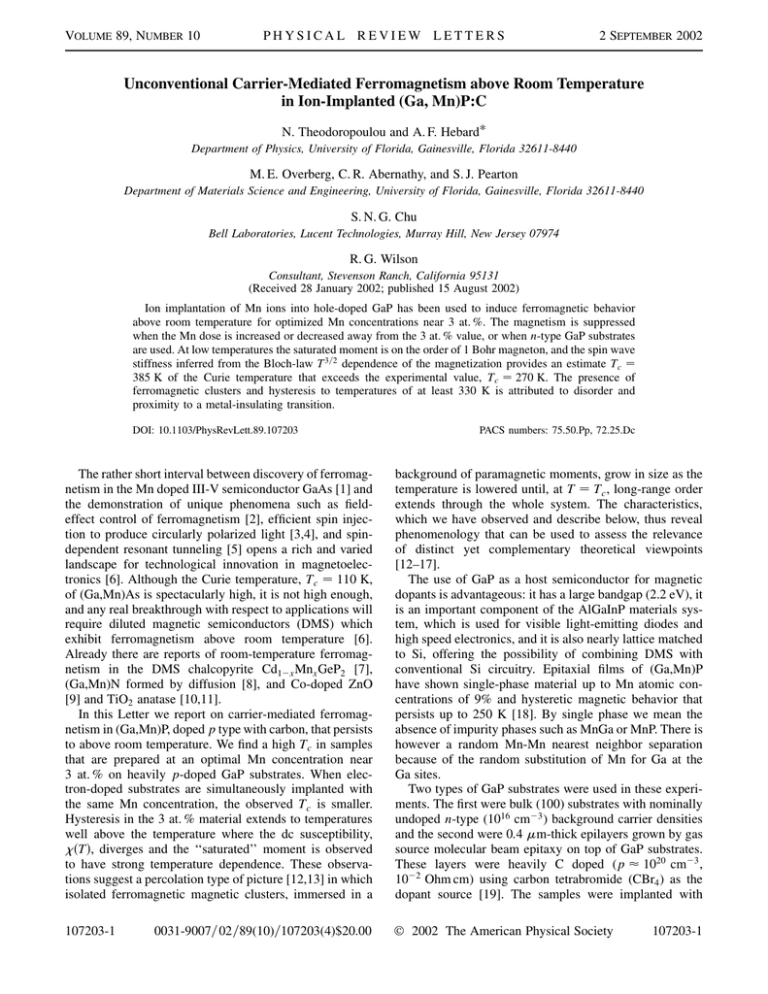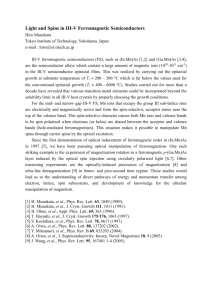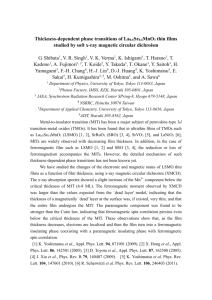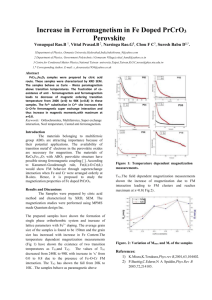Unconventional Carrier-Mediated Ferromagnetism above Room Temperature in Ion-Implanted (Ga, Mn)P:C
advertisement

VOLUME 89, NUMBER 10 PHYSICAL REVIEW LETTERS 2 SEPTEMBER 2002 Unconventional Carrier-Mediated Ferromagnetism above Room Temperature in Ion-Implanted (Ga, Mn)P:C N. Theodoropoulou and A. F. Hebard* Department of Physics, University of Florida, Gainesville, Florida 32611-8440 M. E. Overberg, C. R. Abernathy, and S. J. Pearton Department of Materials Science and Engineering, University of Florida, Gainesville, Florida 32611-8440 S. N. G. Chu Bell Laboratories, Lucent Technologies, Murray Hill, New Jersey 07974 R. G. Wilson Consultant, Stevenson Ranch, California 95131 (Received 28 January 2002; published 15 August 2002) Ion implantation of Mn ions into hole-doped GaP has been used to induce ferromagnetic behavior above room temperature for optimized Mn concentrations near 3 at. %. The magnetism is suppressed when the Mn dose is increased or decreased away from the 3 at. % value, or when n-type GaP substrates are used. At low temperatures the saturated moment is on the order of 1 Bohr magneton, and the spin wave stiffness inferred from the Bloch-law T 3=2 dependence of the magnetization provides an estimate Tc 385 K of the Curie temperature that exceeds the experimental value, Tc 270 K. The presence of ferromagnetic clusters and hysteresis to temperatures of at least 330 K is attributed to disorder and proximity to a metal-insulating transition. DOI: 10.1103/PhysRevLett.89.107203 PACS numbers: 75.50.Pp, 72.25.Dc The rather short interval between discovery of ferromagnetism in the Mn doped III-V semiconductor GaAs [1] and the demonstration of unique phenomena such as fieldeffect control of ferromagnetism [2], efficient spin injection to produce circularly polarized light [3,4], and spindependent resonant tunneling [5] opens a rich and varied landscape for technological innovation in magnetoelectronics [6]. Although the Curie temperature, Tc 110 K, of (Ga,Mn)As is spectacularly high, it is not high enough, and any real breakthrough with respect to applications will require diluted magnetic semiconductors (DMS) which exhibit ferromagnetism above room temperature [6]. Already there are reports of room-temperature ferromagnetism in the DMS chalcopyrite Cd1x Mnx GeP2 [7], (Ga,Mn)N formed by diffusion [8], and Co-doped ZnO [9] and TiO2 anatase [10,11]. In this Letter we report on carrier-mediated ferromagnetism in (Ga,Mn)P, doped p type with carbon, that persists to above room temperature. We find a high Tc in samples that are prepared at an optimal Mn concentration near 3 at. % on heavily p-doped GaP substrates. When electron-doped substrates are simultaneously implanted with the same Mn concentration, the observed Tc is smaller. Hysteresis in the 3 at. % material extends to temperatures well above the temperature where the dc susceptibility, T, diverges and the ‘‘saturated’’ moment is observed to have strong temperature dependence. These observations suggest a percolation type of picture [12,13] in which isolated ferromagnetic magnetic clusters, immersed in a background of paramagnetic moments, grow in size as the temperature is lowered until, at T Tc , long-range order extends through the whole system. The characteristics, which we have observed and describe below, thus reveal phenomenology that can be used to assess the relevance of distinct yet complementary theoretical viewpoints [12–17]. The use of GaP as a host semiconductor for magnetic dopants is advantageous: it has a large bandgap (2.2 eV), it is an important component of the AlGaInP materials system, which is used for visible light-emitting diodes and high speed electronics, and it is also nearly lattice matched to Si, offering the possibility of combining DMS with conventional Si circuitry. Epitaxial films of (Ga,Mn)P have shown single-phase material up to Mn atomic concentrations of 9% and hysteretic magnetic behavior that persists up to 250 K [18]. By single phase we mean the absence of impurity phases such as MnGa or MnP. There is however a random Mn-Mn nearest neighbor separation because of the random substitution of Mn for Ga at the Ga sites. Two types of GaP substrates were used in these experiments. The first were bulk (100) substrates with nominally undoped n-type (1016 cm3 ) background carrier densities and the second were 0:4 m-thick epilayers grown by gas source molecular beam epitaxy on top of GaP substrates. These layers were heavily C doped (p 1020 cm3 , 102 Ohm cm) using carbon tetrabromide (CBr4 ) as the dopant source [19]. The samples were implanted with 107203-1 2002 The American Physical Society 0031-9007=02=89(10)=107203(4)$20.00 107203-1 VOLUME 89, NUMBER 10 PHYSICAL REVIEW LETTERS 250 keV Mn ions to doses of 3–5 1016 cm2 at a temperature of 350 C to maximize crystallinity [20]. These conditions produce relatively flat Mn concentration profiles with peak volume concentrations of 3 or 5 at. % over a projected 0:2 m depth in each sample. Following a rapid thermal anneal, the samples were characterized by transmission electron microscopy, selected area diffraction pattern analysis, and double crystal x-ray diffraction [21]. No evidence of secondary phase formation of GaMn or MnP was found. All magnetic measurements were made with a quantum design SQUID magnetometer with the applied field parallel to the film surface. We attribute our observation of similar results in perpendicular fields to a polycrystalline structure, induced by implant damage and subsequent annealing, which tends to average over any magnetocrystalline anisotropy. Shown in Fig. 1 is a plot of the temperature-dependent magnetization for the 3 at. % (Ga0:94 Mn0:06 P) sample cooled in a field of 500 Oe. A temperature independent diamagnetic contribution, obtained at high field, was subtracted from the background. In contrast to (Ga,Mn)As [22] the temperature-dependent magnetization has the classic convex outwards shape but with a substantial tail extending to higher temperatures. The Curie temperature, Tc 270 K, indicated by the vertical dashed line, is defined as the inflection point and does not shift in position H=500 Oe TC 60 80 40 20 ∆ M(emu/gMn) MFC(emu/g Mn) 80 H=500 Oe 60 40 20 0 0 50 100 150 200 250 300 350 Θf Temperature(K) 0 0 50 100 150 200 250 300 350 Temperature(K) FIG. 1 (color online). Temperature dependence of field-cooled (FC) magnetization (per gram Mn) at an applied field H 500 Oe. At low temperatures a Bloch-law (T 3=2 ) dependence (solid line) was found. The dashed lines are 95% confidence bands. The dashed line at Tc 270 K marks the field independent inflection point (Curie temperature) and the vertical arrows in the main panel and the inset mark the ferromagnetic Curie temperature, f 236 K. Inset: Temperature dependence of the difference M between FC and zero-field cooled (ZFC) magnetizations taken in a field of 500 Oe. 107203-2 2 SEPTEMBER 2002 for similar data sets taken in different fields and sample orientations. At low temperatures the saturated moment, M0 gB S, is calculated to be about 1 Bohr magneton (B ) per Mn ion, thus implying that for a g factor of 2, the spin S 1=2. This value is a factor of 5 less than S 5=2 expected for the half-filled d band of divalent Mn, a discrepancy due in part to strong antiferromagnetic coupling among the more closely spaced randomly positioned Mn ions [14], but also due to disorder effects which give rise to a wide distribution of exchange couplings and hopping integrals, thereby excluding the participation of many of the Mn ions in the ferromagnetism [12]. The solid line is a three parameter fit to an expression of the form, MT M0 1 T , over the temperature range T 160 K. The observation of a Bloch-law dependence with exponent 3=2 is expected for ferromagnets and reflects the presence of long-wavelength thermally excited spin waves. The dashed lines delineate the 95% confidence band for the best-fit parameters 1:516 and 1:0935 104 . We obtain an equally good fit with almost identical parameters for data taken at 1000 Oe. The inset of Fig. 1 shows the temperature-dependent difference M MFC MZFC between field-cooled (FC) and zero-field-cooled (ZFC) magnetization curves taken at 500 Oe. This subtraction advantageously eliminates para- and diamagnetic contributions and simultaneously indicates the presence of hysteresis if the difference is nonzero. It should be noted that the knee of this curve occurs at a lower temperature than the knee of the FC curve (main panel) and moves to an even lower temperature at higher measuring fields. This trend can be understood by realizing that at a given temperature, M 0 if the measuring field is higher than the maximum field at which hysteresis is observed in MH loops acquired at the same temperature. Examples of such loops are shown in Fig. 2. Hysteresis with a coercive field Hc 100 Oe is quite pronounced at 250 K (lower panel) to fields as high as 600 Oe. At lower fields, hysteresis similar to that shown at 300 K in the upper panel of Fig. 2 extends to 330 K. The FC-ZFC subtraction is particularly effective when there are small amounts of ferromagnetic material in the presence of a large diamagnetic and/or paramagnetic background. This situation ensues when n-type rather than p-type GaP is implanted with 3 at. % Mn (Fig. 3, upper panel) or p-type GaP is implanted with 5 at. % Mn (Fig. 3, lower panel). The p- and n-type samples were implanted at the same time and subjected to identical anneals. These data show that the maximum FC-ZFC difference, M, is reduced by a factor of 15–20 and the Tc by a factor of 6, over the temperature range 300 K to near 50 K. Accordingly, an optimized Tc is sensitive to both the carrier and the Mn concentrations. Furthermore, ferromagnetic impurity phases such as MnGa (Tc > 300 K) [22] and MnP (Tc 291 K) [23] are not responsible, since an increase of Mn leads to less, not more, magnetism. 107203-2 5 0 -5 HC=50 Oe -10 40 20 250K 0 -20 -40 HC=100 Oe -800 -400 0 H(Oe) 400 800 FIG. 2 (color online). Magnetization loops showing moderate hysteresis with coercive field, Hc 50 Oe (upper panel) at 300 K and a stronger hysteresis with Hc 100 Oe (lower panel) at 250 K. 4 1 kOe n-GaP Mn 3% 160 3 2 1 6 0.5 kOe p-GaP:C Mn 5% 140 120 100 χdc ∆M(emu/gMn) ∆M(emu/gMn) Although our observations confirm conventional ferromagnetism at low temperatures, the magnetic behavior is considerably more complicated at higher temperatures as shown by the Fig. 4 plots of the temperature-dependent inverse dc susceptibility 1 T (main panel) and saturation moment Ms T (inset). The data for these plots were obtained at selected temperatures by recording MZFC H to the maximum available field of 5 T. A diamagnetic contribution, obtained at high field, varied less than 1% over the temperature range studied and was subtracted from the 4 2 SEPTEMBER 2002 data. We used a Langevin functional dependence to determine dMZFC =dH and Ms T at each temperature. At low fields, MZFC is linear in H, thereby allowing a convincing determination of . We identify the ferromagnetic Curie temperature f 236 K (vertical arrow) by a linear extrapolation of 1 T to zero. The hysteresis and accompanying saturated moment extend with diminishing magnitude to substantially higher temperatures: 330 K for the measured hysteresis and 390 K for a presumptuous linear extrapolation of Ms T to zero. To interpret the enhanced Curie constant derived from the susceptibility data in Fig. 4, we assume for simplicity the presence of uniform size clusters each containing pc Mn ions per cluster. Each Mn ion carries a magnetic moment Mn . Using the expression for the Curie constant, C pc N0 2Mn =3kB , where N0 is the number of Mn atoms per gram Mn and kB is the Boltzmann constant, we calculate from the slope of 1 T, the result, pc 2Mn 4102B . For divalent Mn ions with half-filled d shells, Mn 5B , and we thus find pc 8. The data presented here not only show that roomtemperature ferromagnetism is obtainable in (Ga,Mn)P:C but also provide a meaningful confrontation with present theories [12–17] describing ferromagnetism in DMS. The ferromagnetism is clearly carrier mediated [12–16] and is optimized for hole-doped substrates with Mn concentrations near 3 at. %. Higher concentrations of Mn are deleterious because of increased antiferromagnetic coupling [14] and a possible disorder-induced selfcompensation [16]. Our experimental determination of the prefactor discussed above allows a direct calculation of the spin wave 80 M s (emu/g Mn) 300K (gMn Oe/emu) 10 PHYSICAL REVIEW LETTERS -1 M(emu/g Mn) M(emu/g Mn) VOLUME 89, NUMBER 10 70 60 50 40 30 20 10 80 0 160 200 240 280 320 360 Temperature(K) 60 40 Θ f =236 K 20 2 0 0 0 50 100 150 200 250 300 Temperature(K) FIG. 3 (color online). Temperature dependence of the difference between FC and ZFC magnetizations (per gram Mn) for (upper panel) n-type GaP implanted with 3 at. % Mn and (lower panel) p-type GaP:C implanted with 5 at. % Mn. The measuring fields are indicated in the upper right-hand corners of each panel. 107203-3 240 260 280 300 320 340 Temperature(K) FIG. 4 (color online). Temperature dependent inverse susceptibility extrapolated (dashed line) to f 236 K. The inset shows the temperature-dependent ‘‘saturated magnetization’’ derived from fits of the field-dependent magnetization at each temperature to a Langevin function dependence as described in the text. For comparison, the solid line reproduces MT at 1000 Oe shown in the inset of Fig. 1. 107203-3 VOLUME 89, NUMBER 10 PHYSICAL REVIEW LETTERS stiffness D, a parameter which describes the energy dispersion, E Dk2 , of the spin wave excitations (magnons). We find from the thermodynamic result [24], corrected by a ! 2. spin-dependent prefactor [15], the value D 167 meV A 2 ! for Fe. Substituting For comparison, D 281 meV A ! 2 , S 5=2, and NMn 1:5 1021 cm3 D 167 meV A for the volume density of Mn ions into the expression [25], kB Tccoll 2S 1D62 NMn 2=3 gives an estimate Tccoll 385 K for the upper bound on Tc due to longwavelength collective fluctuations. This value is higher than the measured Tc 270 K and consistent with the fact that mean field theory usually overestimates the ordering temperature. At temperatures near and above Tc , clusters in a disordered medium seem to be playing an important role [12,13,16,17]. The presence of spin clusters is often associated [26] with a 1 T dependence, which approaches zero with positive curvature but which, at sufficiently high temperatures, has a linear dependence extrapolating to the paramagnetic Curie temperature, p . It is therefore reasonable to argue that at higher temperatures 1 T must eventually curve upwards and approach a slope larger than shown in Fig. 4. If so, then a linear extrapolation to 1 T p 0 would give a P considerably larger than f . As T increases beyond Tc and the ferromagnetic clusters decrease in size and number, there is a decreasing saturated moment (Fig. 4, inset), since the remaining paramagnetic regions cannot be driven into saturation without the assistance of internal Weiss fields. Disorder and proximity to a metal-insulator transition, which may be responsible for the enhanced Tc ’s of the clusters [12], may also give rise to a reduced spin stiffness and the anomalously high Curie constant. Based on this evidence of ferromagnetic behavior above room temperature, it is not unreasonable to expect that even higher Tc can be obtained by further optimization of the Mn and hole dopant concentrations. The authors gratefully appreciate discussions with S. Arnason on experiment and R. Bhatt, P. Kumar, and D. Maslov on theory. The work at UF is partially supported by NSF DMR-0101438 (S. J. P.) and DMR-0101856 (A. F. H.), while that of R. G. W. is partially supported by ARO. *Electronic address: afh@phys.ufl.edu [1] H. Ohno and F. Matsukura, Solid State Commun. 117, 179 (2001). 107203-4 2 SEPTEMBER 2002 [2] H. Ohno, D. Chiba, F. Matsukura, T. Omiya, E. Abe, T. Dietl, Y. Ohno, and K. Ohtani, Nature (London) 408, 944 (2000). [3] R. Fiederling, M. Keim, G. Reuscher, W. Ossau, G. Schmidt, A. Waag, and L. W. Molenkamp, Nature (London) 402, 787 (1999). [4] Y. Ohno, D. K. Young, B. Beschoten, F. Matsukura, H. Ohno, and D. D. Awschalom, Nature (London) 402, 790 (1999). [5] H. Ohno, Science 281, 951 (1998). [6] S. A. Wolf, D. D. Awschalom, R. A. Buhrman, J. M. Daughton, S. von Molnar, M. L. Roukes, A. Y. Chtchelkanova, and D. M. Treger, Science 294, 1488 (2001). [7] G. A. Medvedkin, T. Ishibashi, T. Nishi, and K. Hiyata, Jpn. J. Appl. Phys. 39, L949 (2000). [8] M. L. Reed, N. A. El-Masry, H. H. Stadelmaier, M. K. Ritums, M. J. Reed, C. A. Parker, J. C. Roberts, and S. M. Bedair, Appl. Phys. Lett. 79, 3473 (2001). [9] K. Ueda, H. Tabata, and T. Kawai, Appl. Phys. Lett. 79, 988 (2001). [10] S. A. Chambers et al., Appl. Phys. Lett. 79, 3467 (2001). [11] Y. Matsumoto, M. Murakami, T. Shono, T. Hasegawa, T. Fukumura, M. Kawasaki, P. Ahmet, T. Chikyow, S. Koshihara, and H. Koinuma, Science 291, 854 (2001). [12] M. Berciu and R. N. Bhatt, Phys. Rev. Lett. 87, 107203 (2001). [13] A. Kaminski and S. Das Sarma, Phys. Rev. Lett. 88, 247202 (2002). [14] T. Dietl, H. Ohno, F. Matsukura, J. Cibert, and D. Ferrand, Science 287, 1019 (2000). [15] J. König, H. H. Lin, and A. H. MacDonald, Phys. Rev. Lett. 84, 5628 (2000). [16] V. I. Litvinov and V. K. Dugaev, Phys. Rev. Lett. 86, 5593 (2001). [17] M. van Schilfgaarde and O. N. Mryasov, Phys. Rev. B 63, 233205 (2001). [18] M. E. Overberg, B. P. Gila, C. R. Abernathy, S. J. Pearton, N. A. Theodoropoulou, K. T. McCarthy, S. B. Arnason, and A. F. Hebard, Appl. Phys. Lett. 79, 3128 (2001). [19] C. R. Abernathy, Mater. Sci. Eng., R14, 203 (1995). [20] S. Kucheyev, J. Williams, and S. Pearton, Mater. Sci. Eng., R 33, 51 (2001). [21] M. E. Overberg et al., J. Vac. Sci. Technol. B 20, 969 (2002). [22] M. Tanaka et al., Appl. Phys. Lett. 62, 1565 (1993). [23] Y. Shapira, N. F. Oliveira, C. C. Becerra, and S. Foner, Phys. Rev. B 29, 361 (1984). [24] F. J. Dyson, Phys. Rev. 102, 1230 (1956). [25] J. Schliemann, J. König, H. H. Lin, and A. H. MacDonald, Appl. Phys. Lett. 78, 1550 (2001). [26] B. D. Cullity, Introduction to Magnetic Materials, Addison-Wesley Series in Metallurgy and Materials (Addison-Wesley, Reading, Massachusetts, 1972). 107203-4



![Photoinduced Magnetization in RbCo[Fe(CN)6]](http://s3.studylib.net/store/data/005886955_1-3379688f2eabadadc881fdb997e719b1-300x300.png)

